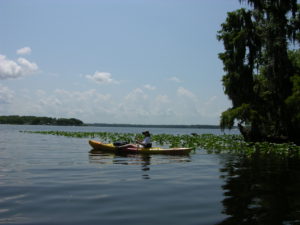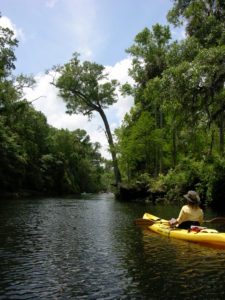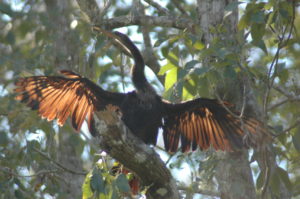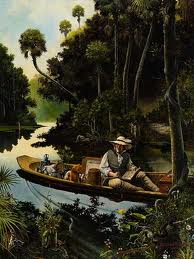 St. Johns River: Bartram’s Battle Lagoon Kayak (& Canoe) Tour
St. Johns River: Bartram’s Battle Lagoon Kayak (& Canoe) Tour
Group size: 1 – 24 paddlers
Trip time: Short: (Battle Lagoon & Bartrams camp site), 3 hours.
Long: (above plus 1/2 Alexander Spring Run, 6 – 6.5 hours
Skill level: Suitable for intermediate and expert paddlers. Your main concern here is strength and endurance. Six hours of paddling can be tiring for some, even though we’ll stop a couple of times along the way.
Cost
Most guided tours are $50 per person. (includes boat, paddle, vest, shuttling and your guide)
Using your Own Boat – $40. (many paddlers with their own boats like to join us to learn more about the history, archaeology and natural history of these rivers).
Dates
Join a scheduled tour (see tour calendar ), or suggest one. Find a free date on the calendar and suggest the trip of your choice. If there are no conflicts, we’ll post it!
OR
Schedule a private tour. Use contact form, email us at riverguide2000@yahoo.com or call (386-454-0611)
Location
Check the River Locator Map or Click the link below for a local map and then use zoom and panning arrows to explore the area. (Note: the marker is NOT our meeting place, but a nearby landmark.
Local Map Description
Description
This trip is part of our “Wild Florida Chronicles” series, in which we visit some natural areas described by early naturalists and explorers. Some of these places have changed considerably, while others would probably be recognized by chroniclers from a couple of hundred years ago.
We do two versions of this tour. The shorter tour lasts about 2.5 – 3 hours and takes us to Battle Lagoon and the campsite William Bartram used in 1774. We begin in a wide expanse of the St. Johns River where we skirt past open marshes of floating ferns and water lilies before entering a narrower channel. Passing Bartram’s “Battle Lagoon” (see “History” below), we’ll stop in for a look at his campsite which he described in some detail. It’s refreshing to see how little the site has changed. A nice palm forest is over-topped by tall, lanky hackberry trees, maples and hickory. Widely scattered shrubs and little ground cover make this a good campsite even today. Walking over this shelly knoll, (an Indian midden that was already ancient by Bartram’s time), efforts to conjure images of Bartram’s Florida are aided by a couple of scrawny wild orange trees, reminiscent of the small orange grove he found here.
 On the longer (6 – 6.5 hours) round-trip paddle, we begin with the same route as described for the shorter version above. From there, we continue upstream on the St. Johns a couple of miles and then enter the mouth of Alexander Spring run. The slight tannic stain of the water hints at the lush swamps lining much of this runs upper reaches. Ascending the stream, the channel narrows and we find ourselves increasingly within the river forest rather than mere passersby. Ash trees, maple, river elm, cypress and gum trees arch overhead and practically reach one another to form a complete canopy by the time we stop our ascent (we do not reach the headspring, which is a few miles upstream from this point). After a brief stretch/snack break, we return downstream along the same route that brought us.
On the longer (6 – 6.5 hours) round-trip paddle, we begin with the same route as described for the shorter version above. From there, we continue upstream on the St. Johns a couple of miles and then enter the mouth of Alexander Spring run. The slight tannic stain of the water hints at the lush swamps lining much of this runs upper reaches. Ascending the stream, the channel narrows and we find ourselves increasingly within the river forest rather than mere passersby. Ash trees, maple, river elm, cypress and gum trees arch overhead and practically reach one another to form a complete canopy by the time we stop our ascent (we do not reach the headspring, which is a few miles upstream from this point). After a brief stretch/snack break, we return downstream along the same route that brought us.
Wildlife
These days, the alligator population along this stretch of the St. Johns is nothing like the horde that Bartram saw, but you can expect to see a few sunning on the river bank and fallen logs.
Wading birds, osprey, cormorants, anhingas and the occasional bald eagle can be seen on the open St. Johns River. In the narrower channels, we become more aware of the forest birds including (depending on the season) parula,  black and white and prothonotary warblers, catbirds, phoebes, great crested flycatchers, belted kingfishers, and more. Otters are plentiful in this area, as well, but we don’t spot them as frequently here as we would on rivers like Rainbow and Silver.
black and white and prothonotary warblers, catbirds, phoebes, great crested flycatchers, belted kingfishers, and more. Otters are plentiful in this area, as well, but we don’t spot them as frequently here as we would on rivers like Rainbow and Silver.
History
When England took possession of Florida in 1763, scholars and scientists of all persuasion were eager to learn what mysteries their new land held. Toward that end, a man named Fothergill contracted with the son of his friend John Bartram to journey down to Florida and report back on the plants, animals and people found there. His selection of the 35 year old William was fortuitous, to say the least. The book that was spawned by this four year adventure was not only an invaluable source of information about the nature and peoples of Florida (including the first Seminoles), it would prove to be a significant influence on the Romantic period of literature. Through his lyrical, dreamy descriptions of the places he saw would be echoed (in some cases bordering on plagiarism) by notables as Wordsworth, Coleridge and Chateaubriand.
 When William Bartram’s account of his exploration was published, in 1791, it was an immediate success. However, some of his natural observations were met with skepticism. Some of the species he described and events he recounted seemed, to some critics, to be fanciful exaggerations of an imaginative, albeit very learned youth. It would take decades of further exploration and subsequent observations by later naturalists before Bartram was fully vindicated and recognized as one of America’s greatest naturalist explorers.
When William Bartram’s account of his exploration was published, in 1791, it was an immediate success. However, some of his natural observations were met with skepticism. Some of the species he described and events he recounted seemed, to some critics, to be fanciful exaggerations of an imaginative, albeit very learned youth. It would take decades of further exploration and subsequent observations by later naturalists before Bartram was fully vindicated and recognized as one of America’s greatest naturalist explorers.
Among the most controversial (and exciting) tales in Bartram’s book, “Travels” was the alligator attacks he survived (barely) in a side channel of the St. Johns River. He dubbed the spot Battle Lagoon.
Difficulty
The short version of this trip (to Battle Lagoon and the campsite and then back to take-out site) takes only about 3 hours and is easy for all skill levels
The longer version (past Battle Lagoon, the campsite and well up Alexander Spring Run) can be a bit more challenging. While the conditions are easy (slow paddling on gently flowing water), the length of the paddle (about 6 – 6.5 hours) can be challenging.
The main consideration, for both the shorter and longer tour, is wind. If it’s a breezy day, paddling the open water can be challenging. If it’s too strong, we won’t go out. As always, consider your strength and endurance carefully
